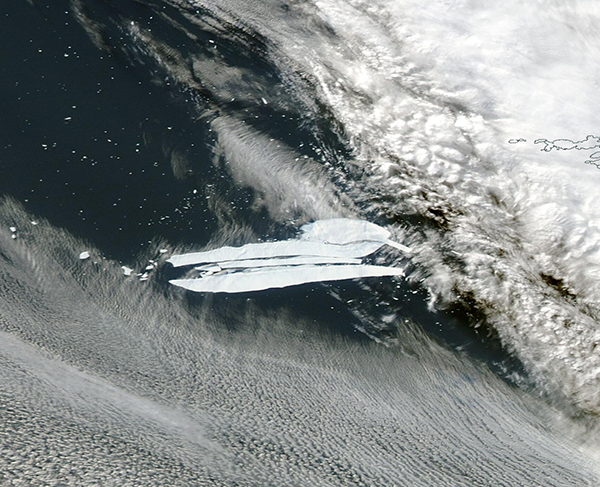Images
May 29, 2023 - Iceberg A-76A Breaks Up
Tweet
When it first calved from Antarctica’s Ronne Ice Shelf in May 2021, Iceberg A-76 was the largest iceberg on the planet. Initially similar in size to Spanish island of Majorca, the massive berg quickly split into three smaller pieces. The largest of those pieces was a rectangular-shaped tabular iceberg which was named A-76A.
By October 2022, A-76A had drifted nearly 1,200 miles (2,000 km) northward and had entered the Drake Passage. The passage is a turbulent body of water between South America’s Cape Horn and Antarctica’s South Shetland Islands. Icebergs passing through the Drake Passage often are carried quickly northward into warmer waters where they usually begin to melt.
By April 28, 2023, the U.S. National Ice Center (USNIC) reported that a large chunk of ice had split off of A-76A, and they named that new iceberg A-76D. By mid-March, USNIC confirmed that additional breaks in A-76A had resulted in the formation of four more new icebergs. These icebergs, dubbed A-76E, A76-F, A76-G, A76-H, and A76-I, were first spotted by Dr. Klaus Strübing, former director and professor at the Federal Maritime and Hydrographic Agency of Germany (BSH), and Dr. Jan Lieser of Australia’s Bureau of Meteorology. The new icebergs were confirmed by USNIC Analysts using a MODIS image from May 12. First signs of the calving event were visible on MODIS imagery as early as May 8.
The Moderate Resolution Imaging Spectroradiometer (MODIS) on board NASA’s Aqua satellite acquired a true-color image of the highly-fragmented A-76A on May 19. The shattered A-76A is the longest piece and located south of and just below the newly-calved bergs. The tip of South Georgia Island can be seen in the northeast.
Image Facts
Satellite:
Aqua
Date Acquired: 5/19/2023
Resolutions:
1km (163.6 KB), 500m (435.6 KB), 250m (315.5 KB)
Bands Used: 1,4,3
Image Credit:
MODIS Land Rapid Response Team, NASA GSFC
Tweet
When it first calved from Antarctica’s Ronne Ice Shelf in May 2021, Iceberg A-76 was the largest iceberg on the planet. Initially similar in size to Spanish island of Majorca, the massive berg quickly split into three smaller pieces. The largest of those pieces was a rectangular-shaped tabular iceberg which was named A-76A.
By October 2022, A-76A had drifted nearly 1,200 miles (2,000 km) northward and had entered the Drake Passage. The passage is a turbulent body of water between South America’s Cape Horn and Antarctica’s South Shetland Islands. Icebergs passing through the Drake Passage often are carried quickly northward into warmer waters where they usually begin to melt.
By April 28, 2023, the U.S. National Ice Center (USNIC) reported that a large chunk of ice had split off of A-76A, and they named that new iceberg A-76D. By mid-March, USNIC confirmed that additional breaks in A-76A had resulted in the formation of four more new icebergs. These icebergs, dubbed A-76E, A76-F, A76-G, A76-H, and A76-I, were first spotted by Dr. Klaus Strübing, former director and professor at the Federal Maritime and Hydrographic Agency of Germany (BSH), and Dr. Jan Lieser of Australia’s Bureau of Meteorology. The new icebergs were confirmed by USNIC Analysts using a MODIS image from May 12. First signs of the calving event were visible on MODIS imagery as early as May 8.
The Moderate Resolution Imaging Spectroradiometer (MODIS) on board NASA’s Aqua satellite acquired a true-color image of the highly-fragmented A-76A on May 19. The shattered A-76A is the longest piece and located south of and just below the newly-calved bergs. The tip of South Georgia Island can be seen in the northeast.
Image Facts
Satellite:
Aqua
Date Acquired: 5/19/2023
Resolutions:
1km (163.6 KB), 500m (435.6 KB), 250m (315.5 KB)
Bands Used: 1,4,3
Image Credit:
MODIS Land Rapid Response Team, NASA GSFC




